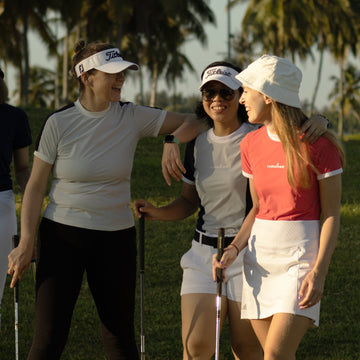Fashion has long evolved to become not just a mere statement of style, but also a meaningful expression of individuality. While fashion has historically been rooted in aesthetics, modern fashion trends give us a glimpse into what else it can do. Long gone from its focus on appearance and social status, fashion now serves an even bigger purpose—to create impact. The shift towards a purposeful era of fashion emphasizes the power of both the clothing and the consumer. For clothing, it shows its capabilities of bringing forward advocacy-driven pieces that remain stylish, empowering its consumers to make good fashion choices that resonate with their individuality. Multiple fashion trends have had their share of being part of this purposeful movement, from graphic tees with social statements and sustainably made pieces. But, the skort stands out as a powerful example, blending style with practicality in a way that also challenges gender norms. Today, skorts are more than just a wardrobe must-have; they are now a powerful statement of change and purpose, representing how far we’ve come from fashion being solely about aesthetics. Discover how this versatile piece of clothing is transforming fashion today and empowering individuals to stand with change.
Skorts as a Symbol of Women Empowerment
Skorts, a unique blend of skirts and shorts, have come to symbolize women’s empowerment, reflecting the balance of femininity and functionality that supports the modern woman’s active lifestyle. Starting out as an option for comfort and security while cycling, early skort iterations were stylized purely for functionality and less for aesthetics. Wide-legged pants with a flat front were the go-to for women bikers which disguised the practicality of trousers that were previously reserved for men. It was only in Wimbledon in 1931 did the world got a glimpse of the skort we might envision today. In a tennis match against British athlete Joan Lycett, Spanish tennis player Lili Alvarez made history for appearing on the court with a pair of culottes that were carefully designed with ruffled fabric that created the look of the traditional tennis skirt. A huge uproar from the media was observed during this time, overshadowing her victory against her opponent. In her fashion choice, Lili Alvarez made a clear statement on progressiveness and kickstarted women’s empowerment through fashion.
It took decades for skorts to become a classic fashion piece. Preferences were changing and trends were as dynamic as ever. Deirdre Clemente, a professor of history specializing in the fashion industry at the University of Las Vegas, shared that skorts emerged as a statement against the masculine functionality of pants, but later dissolved once it became acceptable for women to wear. Skorts were only rid of their fad nature by the 1960s with the emergence of the mini skirt and in no time, it was back in the trends. Thanks to this, women now had better and even more fashion choices that were not anymore limited to sports and running errands, enabling them to strike a balance in their personal and professional lives.
Today, skorts are a staple wardrobe piece that merges the elegance of a skirt and the practicality of shorts. In a world where they are often expected to meet societal standards of being nurturing but ambitious, skorts provide the comfort that the modern woman needs, and the stylishness that the modern woman wants to achieve. This versatility makes skorts an ideal choice for women who refuse to be confined by tradition and eliminates the decision to pick from either style or functionality.
Sustainability in Skorts
Skorts are not only a versatile choice, but also a conscious one. By offering flexibility in style, skorts help reduce the need for multiple pieces, supporting the creation of an eco-friendly capsule wardrobe. It also promotes the use of more sustainable materials in its production given its versatile pattern. Skorts in all kinds of different materials are now emerging for different consumer preferences. The usage of eco-friendly fabrics such as organic cotton and recycled polyester not only decreases fashion’s environmental impact but also provides consumers with increased comfort and assurance of its sustainable origins.
While we are free to use fashion as a means of self-expression, it is important to note the responsibility of upholding sustainability that comes with it. It is crucial to be aware of the brands we choose to support and what measures they are taking towards sustainable operations because while the fashion industry thrives on emerging trends and fads, it also possesses the characteristic of being a contributing factor to an environmental crisis. The fast fashion industry in itself poses large risks to the state of our environment, generating 17 million tons of textile waste annually with approximately 85% ending up in landfills. This industry is also responsible for around 10% of global carbon emissions, making it one of the most significant polluting sectors. Despite these challenges, fortunately, there is a growing consumer interest and demand for sustainable apparel, offering a chance for a long-term sustainable future. In a report by McKinsey & Company (2022), data showed that 67% of consumers consider sustainability prior to making a purchase. In terms of textiles, it was also found that making the switch towards recycled fibers in clothing production greatly reduced carbon emissions by up to 70%. By choosing to support brands that uphold sustainability, consumers have the power to drive purposeful change through conscious consumerism.
Multiple brands have made a conscious effort to integrate sustainability into their operations. Fairmonde Golf is an ideal example of this. Known for our high-performance and sustainable golf apparel, we feature contemporary designs on yoga-inspired clothing, allowing our target market to style their Fairmonde pieces on and off the green. Committed to promoting environmental responsibility, Fairmonde also uses sustainable materials through ethical practices in clothing production, upholding another key commitment in their sustainable efforts. By remaining true to its promise of providing stylish yet sustainable options to the growing population of female golfers, Fairmonde caters to the demand whilst promoting ethical practices.
|
Fairmonde Ace A-Line Skort - Navy  Access the skort here |
|
|
Fairmonde Double Pocket Skort - Black  Access the skort here |
|
|
Fairmonde Verve Side-Pleated Skort - Beige 
Access the skort here
|
Check out their website for more golf pieces!
The Cultural Impact of Golf Skorts
Clemente said it best, “Skorts represent the compromise between the offensive–shorts– and the polite, the skirt.” which goes to show how impactful the trend is on culture and tradition. Skorts made way for multiple body types to feel at ease in their own skin, all the while challenging its traditional narrative of being for a specific market only. Not to mention, its hybrid design allowed for women to seamlessly go through their day without the need to change clothes.
This type of universality also transcends out of women’s fashion as it was originally created to purposely blur the lines between male and female clothing in the name of comfort and style. The structure of this garment has effectively foreshadowed the state of fashion in the modern world where gender neutrality is the standard. Today, as we celebrate individuality and fluidity through fashion, skorts puts itself at the forefront of this movement, offering itself as an option for personal preference rather than conformity to societal expectations. This notable shift is a huge step towards the broader cultural acceptance of diversity in today’s society.
Skorts have also become an integral part of the body positivity movement, providing a comfortable and flattering option for all. In its roots, the skort was made to combine the masculinity of the shorts with the femininity of the skirt, making it an encouraging option to dress for their preference and their preference only. Additionally, its design allows it to adapt itself to various body types given its combination of the short and the skirt. The inclusive nature of skorts mirrors the goals of the body positivity movement, celebrating gender neutrality and diversity through clothes without judgement.
Culturally, the skort has come a long way from its original purpose. Today, it emerges in a plethora of styles and continues to be developed in ways that support the dynamic shift in fashion norms and values. From the work day to the casual weekend, skorts are making a name for themselves across the globe, proving the universal desire of consumers for more versatile fashion options without compromising one function over the other. This global demand translates itself to be the acceptance of more functional clothing that is also non-hindering to self-expression. Skorts are not anymore just a wardrobe staple, but also a powerful representation of modern fashion values.
Activism Through Fashion
Skorts are not just an embodiment of the changing times; they are also a declaration of activism towards women’s rights and environmental sustainability. Similar to graphic tees with social messages, skorts are a prime example of how clothing can make a statement beyond aesthetics. Having been made and popularized in a time where fashion was gender-specific, skorts have always been a part of activist fashion. The way in which it combines femininity and masculinity is symbolic to the struggles that women face today. Often times, even in a more progressive society, societal expectations when it comes to clothing are still expected, but at least with skorts and how it is able to brand itself as a versatile garment that defies gender norms, individuals consciously contribute to a more inclusive fashion movement.
Looking back at Wimbledon 1931, we can recall how skorts started out as a revolutionary garment for female athletes. While it graced women with more freedom, literally and figuratively, it sparked social change among the fashion industry, making way for even more revolutionary clothing that made statements for social causes. It was also able to facilitate a domino effect in women empowerment given that it also paved the way for women’s rights to wear what was once deemed as “men’s clothing”. For one, contemporary fashion has even used skorts as a symbol of social change by highlighting their functional and stylish attributes and encouraging more women to make skorts a part of their active lifestyle. The evolution of skorts from statement to staple has surely highlighted the impact fashion has on societal issues, leaving the unique decision up to the consumer to partake in this movement.
Visual Examples
 Spanish tennis player, Lili Alvarez, makes history at Wimbledon 1931 not just for her victory, but for sporting one of the first skort iterations. |
 Skorts for men featured in Fendi’s Fall 2024 Collection. |
 Having come far from traditional tennis outfits, Naomi Osaka graces the U.S Open with a Nike x Yoon Ahn collaboration that features the modern bow trend and the classic skort elements. |
In conclusion, skorts embody the dual transformative nature of fashion. One being able to transform one’s identity into something that they wholeheartedly identity with, and the other being one that showcases meaningful activism in a crucial time for change. While fashion is most associated with stylishness, it also comes hand-in-hand with storytelling and advocacy in ways that it allows us to express what we resonate with without the use of words or actions. Skorts have not only become a testament to the changing times, but also a driving force towards a more sustainable fashion era. Nowadays, the impact of skorts extends beyond its functionality and style. It now represents a broader movement and will continue to do so as fashion evolves and adapts to global trends.















